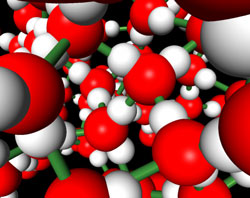Water Molecules, Unite!
Compared with other liquids, water is very sensitive to an electric field. The field strongly “polarizes” water, lining up the charges in the molecules. In the 15 June Physical Review Letters researchers use a new calculation scheme to explain this large electric response. The results shed light on how water polarizes at short distances–the range relevant for the charged pieces of a protein molecule packed tightly among water molecules in biological cells.
At the atomic scale, liquid water forms a dynamic, three-dimensional network, with so-called hydrogen bonds constantly forming and breaking between the V-shaped H2O molecules. At any given moment, each oxygen atom is typically surrounded by four hydrogens–two close ones from its own molecule, and two further away on nearby molecules. At the same time, within each molecule, the oxygen has a bit more negative charge, and the hydrogens are a bit more positive–a charge separation called a dipole.
If you apply an electric field to water, you expect the molecules to align their dipoles along the field lines, on average, like so many compass needles aligning in Earth’s magnetic field. The degree to which they align with and augment the electric field is called polarizability. But in the hydrogen-bonded network of water, the dipoles are already partially aligned with each other, even before you apply the field. Clusters of nearby molecules act as a single, larger dipole, enhancing the field more than they would on their own. This so-called collective effect is one reason for water’s large polarizability. But researchers have wondered how this effect compares with a second one: Each oxygen pulls the hydrogens further from the oxygen in neighboring molecules, which increases the charge separation within each molecule and therefore the strength of each molecule’s individual dipole.
The uncertainty about which effect is bigger arises because the electrons are spread out among the molecules. Calculations and experiments show how the charge varies from place to place, but there is no easy way to assign each bit of charge to a particular molecule. Only in the last decade have physicists perfected mathematical methods to make definitive assignments of charges.
Manu Sharma of the University of California at Davis and his colleagues have now applied the new techniques to water and definitively determined the contributions of the two effects to water’s large polarizability. The team first simulated a few dozen water molecules using only basic laws of physics. To assess the effect of individual molecular dipoles, they computed the dipole for each molecule and found values that were typically 60% bigger than for water vapor, where the molecules don’t interact. To measure the collective effect, they monitored how often the alignments of nearby molecules changed together, and found that collective motions more than doubled the polarization. Both effects contributed to the large polarizability they calculated–a value that agrees well with experiments.
Accounting for individual dipoles also showed that almost all of the collective enhancement comes from neighboring molecules, rather than those further away. Since more distant molecules are unimportant, the strong polarizability should persist even when water is confined in very tight spaces, for example in proteins and other biological molecules. Biophysicists have assumed as much, when modeling the atomic-scale functioning of biomolecules, but these results provide solid evidence.
David Vanderbilt of Rutgers University in New Jersey helped establish the charge accounting scheme. He says that calculating the right polarizability–and the closely related dielectric constant–and disentangling the various contributions is “a kind of milestone” for first-principles theory. “The dielectric constant of liquid water is a complicated thing.”
–Don Monroe
Don Monroe is a freelance science writer in Murray Hill, New Jersey.





